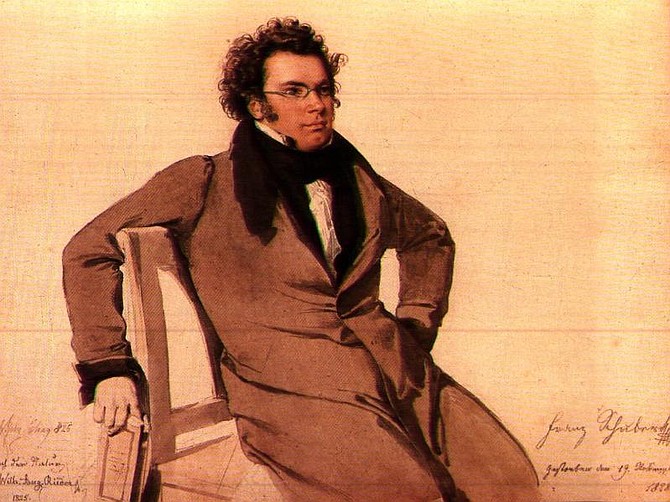 Facebook
Facebook
 X
X
 Instagram
Instagram
 TikTok
TikTok
 Youtube
Youtube

As a part of the transcendent coverage of classical music here at the San Diego Reader we will be doing a deep dive on an upcoming piece of music every so often.
The first piece is Schubert’s Quintet in C major at Mainly Mozart. Next time we will look at Mahler’s Symphony No. 1: Titan at the San Diego Symphony. Those two pieces both come from the Austrian tradition but represent opposite sides of the spectrum when it comes to the scope of the instrumentation. However, both pieces are about the same length.
The traditional way to go about writing a string quitnet is to add a viola to the traditional string quartet line up of violin, violin, viola, cello. For his Quintet in C major, Schubert added a cello instead of a viola.
Big deal? Maybe not in the grand scope of human experience, but in the microsomic realm of chamber music it is worth exploring.
This quintet is the last piece of instrumental music Schubert composed. It was written just a few months before his death in 1828. It’s first public performance was not until 1850 and it was not published until 1853. Since then it has acquired the status of being Schubert’s greatest piece of chamber music.
What about the Trout Quintet? The C major or Cello Quintet has a thoroughness about its composition which exceeds Schubert’s previous efforts including the Trout.
The extra cello, as one might imagine, creates a depth of tone which translates to depth of expression. Maybe Schubert was inspired by the possibilities an extra cello provided. Whatever the case, this is music which compels us to look inward. It was composed in the late summer and into autumn, a time of the year I’ve always found to be introspective.
It is pointless to dramatize Schubert’s composition within the context of his impending demise. Schubert did not know the date his death would arrive. While we would like to think he composed this music as his swansong it adds nothing to what Schubert put on the page.
What Schubert did put on the page was 50 minutes of uninterrupted beauty. If there is one thing which can be said of Schubert, it is that he was a master of melody. Nowhere is he more masterful than in this C major Quintet. It is not only a pinnacle of Schubert’s oeuvre, it is a representative of the best elements of European Romanticism.
The best elements of European Romanticism are truth of emotion, elevation of folk traditions, resistance to industrialization, and connection to nature. The truth of Schubert’s emotion in the C major Quintet is evident for all to hear.


As a part of the transcendent coverage of classical music here at the San Diego Reader we will be doing a deep dive on an upcoming piece of music every so often.
The first piece is Schubert’s Quintet in C major at Mainly Mozart. Next time we will look at Mahler’s Symphony No. 1: Titan at the San Diego Symphony. Those two pieces both come from the Austrian tradition but represent opposite sides of the spectrum when it comes to the scope of the instrumentation. However, both pieces are about the same length.
The traditional way to go about writing a string quitnet is to add a viola to the traditional string quartet line up of violin, violin, viola, cello. For his Quintet in C major, Schubert added a cello instead of a viola.
Big deal? Maybe not in the grand scope of human experience, but in the microsomic realm of chamber music it is worth exploring.
This quintet is the last piece of instrumental music Schubert composed. It was written just a few months before his death in 1828. It’s first public performance was not until 1850 and it was not published until 1853. Since then it has acquired the status of being Schubert’s greatest piece of chamber music.
What about the Trout Quintet? The C major or Cello Quintet has a thoroughness about its composition which exceeds Schubert’s previous efforts including the Trout.
The extra cello, as one might imagine, creates a depth of tone which translates to depth of expression. Maybe Schubert was inspired by the possibilities an extra cello provided. Whatever the case, this is music which compels us to look inward. It was composed in the late summer and into autumn, a time of the year I’ve always found to be introspective.
It is pointless to dramatize Schubert’s composition within the context of his impending demise. Schubert did not know the date his death would arrive. While we would like to think he composed this music as his swansong it adds nothing to what Schubert put on the page.
What Schubert did put on the page was 50 minutes of uninterrupted beauty. If there is one thing which can be said of Schubert, it is that he was a master of melody. Nowhere is he more masterful than in this C major Quintet. It is not only a pinnacle of Schubert’s oeuvre, it is a representative of the best elements of European Romanticism.
The best elements of European Romanticism are truth of emotion, elevation of folk traditions, resistance to industrialization, and connection to nature. The truth of Schubert’s emotion in the C major Quintet is evident for all to hear.
Comments